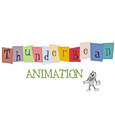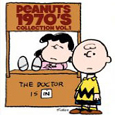Warner Home Video/DC Comics (November 9 2010), single disc, 90 mins, 1.78:1 anamorphic widescreen, Dolby Digital 5.1, Not Rated, Retail: $24.98
Storyboard:
The (not-so, as it turns out) secret origins of Superman, Batman, Wonder Woman, Watchmen, et al, are revealed in this documentary marking DC Comics’ 75th anniversary.

The Sweatbox Review:
No pun intended, but I have a pretty sketchy relationship with comic books. Although I was rapt with the printed adventures of my favorite heroes from a young age, I was just into too many of them! Undoubtedly the spark was lit by seeing Richard Donner’s Superman movie as a six year old in 1978, soon after which my bedroom wall was covered in all things Man Of Steel. I think I’d been aware of the character before, most probably from the Super Friends cartoons of the 1970s, but it was Donner’s film – still the world’s finest comic book motion picture – that kicked my appreciation into high gear.
The Superman comics started to pile up, but as I grew I started to sample more of the other characters: Batman, The Flash (quite a short-lived fascination as I remember!), the Hal Jordan Green Lantern of the late ’70s, and Wonder Woman (both in print and from the Lynda Carter television show). I wasn’t immune to the charms of DC Comics’ rival Marvel either: The Incredible Hulk (again concurrently with the TV series), Fantastic Four, a brief spell of Captain America and of course Spider-Man (also on TV: anyone remember Nicholas Hammond!?), among others including various Disney and cartoon-derived titles, were all picked-up as and when I could afford a copy.

The trouble was that keeping up with their exploits on my meagre childhood savings meant missing out editions here and there, and I never really settled on just one or two characters, save for Superman and Spidey, which I split between for a while in the early ’80s, and an ongoing dip into Mad Magazine throughout the 1990s. By this time, in my infinite wisdom, my money was better saved and spent on movie collecting, mostly on DVD’s precursor format, LaserDisc, where special editions would cost upwards of $50 per title or even $100-plus for a lavish boxed set.
But although I’ve lost contact with the printed comic book page over the years, I’ve never given up on my affection for these costumed heroes, especially specific figures that I’ve continued to follow through television and movie incarnations. When the long-gestating movie version of Spider-Man eventually rolled around in the summer of 2002, bringing with it a new public and media focus on comic books and superheroes in general, the feature-length British/French documentary Once Upon A Time The Superheroes captured the zeitgeist to define the history of those publications, encompassing everything including the industry-wide affecting likes of William Gaines’ pulp comics. The approach may have been a little dry, but watching that film made me lament that I had not stuck by all my favorites and been with them through the sometimes difficult recent times, especially Superman, who remains for me the greatest hero ever created.

He was also the first, of course, and as such he kicks off Secret Origin: The Story Of DC Comics, writer-director Mac Carter’s new documentary that goes someway to redress the leaning in Once Upon A Time The Superheroes that sometimes favored Marvel even though both companies were discussed. But perhaps enjoying that previous attempt to document the development of the comic book medium onscreen has spoiled me, since Carter’s film plays much more as a potted history of sorts, quickly breaking down into a series of smaller character portraits that briefly discuss their introductions and initial success a little too conveniently.
Naturally, produced by DC’s parent company Warner Bros, any retrospective was never going to be a true nitty-gritty exposé or resonate with any nuts and bolts revelations, but even given my “casual” attitude to comic fandom, I learned very little new, which was originally my main point of interest in Secret Origin. There’s usually two reasons anyone would watch a documentary, interest in the subject apart, and that’s to discover more about a topic one would like to find out more about, or for aficionados of a topic to watch and see what is covered, how the information is conveyed, what might be left out (and to see what is possibly wrongly portrayed).
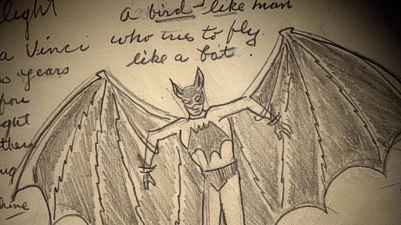
Since Secret Origin acts more as a generalized summing up of DC and its characters, I don’t think long-time fans will find much to engage them outside of the geek prospects of seeing their favorite characters mentioned. On the flipside of this, the documentary works better as background to more casual fans, or those not really that into comic books, where the explanatory tone and character profiles may spark some interest that leads to them picking up a book in future. That’s not to say Carter’s film is a promo puff piece designed to sell DC Comics’ content: one of the major plusses of this documentary is that it never seeks to overtly advertise, only to communicate knowledge, without emphasizing one character over another, which was a relief to me given narrator Ryan Reynolds’ current connection with the upcoming Green Lantern live-action film and the potential for a shameless plug for that film towards the closing comments, which thankfully doesn’t happen here.
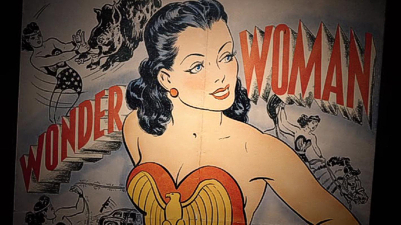
That this information is also presented fairly simply as a combination of talking heads, comic graphics given life via dimensionally expanded motion-comic styled movement and clips from the various TV and film incarnations of DC’s books, also makes the case that this documentary is aimed at a wider audience than the kinds of long-time collectors or core-geeks that make the annual pilgrimage to San Diego’s Comic-Con each year. As such, the presentation and chronology is straightforward: there’s a little on the kinds of risqué pulp magazines and newspaper strip cartoons that predated comic books, before Detective Comics #1 comes along and, four years later, Jerry Siegel and Joe Shuster’s Superman launches the superhero genre proper.
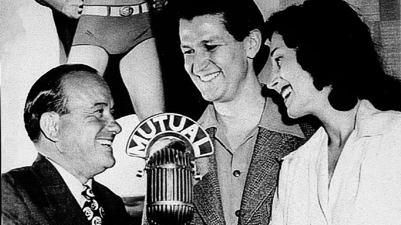
Secret Origin touches on the immigrant themes of Superman which so resonated with Americans of the late 1930s, though the “profile” approach of each character doesn’t really allow for anything more than a collection of “exam pass notes” that gives the viewer a rounded, if not tremendously in-depth, appraisal. With the success of the Man Of Steel, the documentary proceeds to basically provide this same kind of similar background on DC’s big Golden Age names, most prominently Batman, Wonder Woman and a number of their sidekicks and villains, and the debut on radio of The Adventures Of Superman and the Fleischer Studio’s animated Superman films.
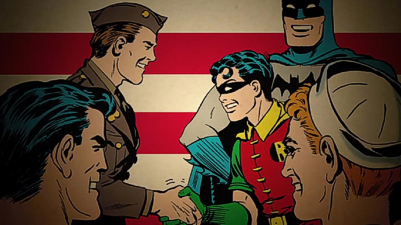
The outbreak of World War II brings about The Justice Society Of America, and a few facts of more interest, but much of it is still lightly touched upon before we’re soon into the 1950s with the Man Of Steel’s television debut in The Adventures Of Superman and the meltdown of comics into bland, child-orientated publications (with a hilarious use of a Pat Boone clip). As we progress into the Silver Age, other characters make their mark: the reinventions of The Flash, Green Lantern, the Justice League Of America and Supergirl and Batman’s rogues’ gallery of villains comes along just in time to make the jump with him to television, in the classic 1960s cult hit (sadly still held up in legal wrangles and only illustrated in publicity photos).
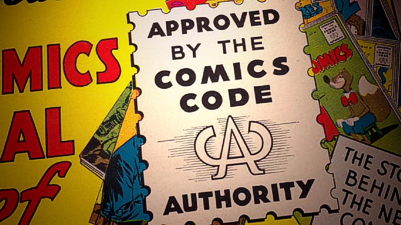
The Bronze Age segment acknowledges DC’s losing the newsstand battle to the pull of Marvel’s growing titles, but not for long: soon the next generation of artists and writers, the same generation that had grown up on the books they were now contributing too, wanted to bring a new, more realistic approach to their work, particularly in a Green Lantern/Green Arrow team-up that tackled many contemporary issues that reverberated with readers and throughout the industry. Television played a big part, too, with Wonder Woman and Super Friends keeping the characters alive as well as, of course, the big screen Superman, which is fittingly given a little attention.
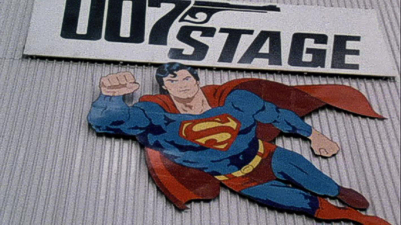
Superman’s three sequels and merchandising phenomena accelerates something of a final dash through The Modern Age, from Frank Miller’s reimagining of Batman, The Dark Knight Returns, and Tim Burton’s films and the celebrated animated series, to Alan Moore’s complete rewriting of the comic book rules in Watchmen and its ensuing “British Invasion” of writers, such as Neil Gaiman and his new version of Sandman. Things are brought up to date with the introduction of the Vertigo label, the Death Of Superman plotline and the descent into too dark material, before the events of September 11, 2001, brought about a rethinking back to the core ideals of the characters that led to the current breaking through of the art form to the wider public by way of conventions, blockbuster movies (Superman Returns thankfully restricted to just a few brief shots) and other mediums, just in time for DC’s 75th anniversary.
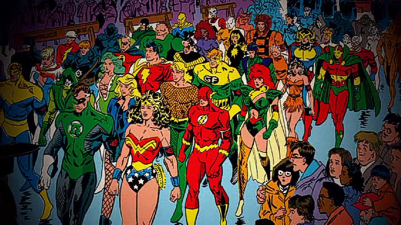
Accompanying Reynolds’ trawl through this history are the interviewees, from the artists and writers themselves to the publishers, who all offer their own comments, anecdotes and perspectives on the medium as art form. Through some (actually rather limited amount of) archive material, occasional creators are referenced to bring their takes on their experiences, racking up the names to include Paul Levitz, Gerard Jones, Mark Waid, Neal Adams, Joe Kubert, Louise Simonson, Irwin Hasen, Dennis O’Neil, Marv Wolfman, Grant Morrison, Julius Schwartz, Len Wein, Neil Gaiman, Miller, Moore and Dwayne McDuffie of the latest Milestone imprint, among some others, for various soundbites.
This final list of participants seemed, to me, to be rather limited in range, especially for a documentary that seems to rely so much on exploring DC’s reach into other territory, particularly television and film, and perhaps it would have been neat to hear from other artists (or even just have them name checked) associated with different incarnations over the years or, at least, the likes of Bruce Timm, Christopher Nolan and Zack Snyder as the current, very publicly recognized screen custodians of these characters. Likewise, much of Secret Origin sticks to the more publicly recognizable characters, shying away from forgotten names or also-rans and concentrating so much on the “stars” that even company and corporate information is lost.

Once we start to delve into the character profiles, the comic book business in general is almost omitted entirely, including what would have been interesting information on National Periodicals name switch to DC Comics and the eventual buyout by Warner Communications. These are referenced, but only in passing or as information interjected at a late stage, and even chief rival the mighty Marvel Comics, and any character crossover specials, are barely spoken of, though amusingly when so, with Julie Schwartz declaring that his creation of the JLA also saved Marvel at a pivotal moment in the industry. Unavoidable to mention is the impact of Bill Gaines’ pulp comics of the 1950s, but that’s about as controversial as it gets, with nothing provided on any creator/corporate ownership fall out, not least the continuing battles between Warners and the Superman creators’ estates.
Which means that, ultimately, for all that Secret Origin manages to include on its primary stable of popular icons, one feels that there are many more interesting stories to hear that haven’t been included. The resulting tone is very much a wonderfully succinct, even nostalgic, retrospective that naturally paints DC and its owners in very much a favorable light. The information is often decent if not revelatory, being an at times rather methodical listing of character highpoints and a few behind the scenes personnel changes, leading me to find The Story Of DC Comics often feeling like a typically well-made (aside from one recurring image issue as discussed below) Warner Home Video bonus feature. A very good, extra-long bonus feature to be sure, but certainly along those lines. As such, geeks and collectors may not find too much super-nourishment, but casual fans may take away a little more knowledge on some of their favorite mainstream characters.
Is This Thing Loaded?
Wow…who killed this disc with Kryptonite!? This is as super-bare bones as they come! There’s nothing here – nothing, nada, zip, zilch. How about a slice of classic DC animation by way of Superman’s Fleischer Studios debut? It’s often been seen on DVD but would have provided something. Or a classic episode of The Adventures Of Superman or any of the Saturday morning cartoon shows that licensed DC characters? There’s not even a bunch of previews for upcoming DC-related releases. Those hoping for their Green Lantern fix by way of the just-released teaser trailer will go unsatisfied.
What about stuffing some extra space with a trailer gallery for a host of DC titles now available on DVD? Heck, I might even be tempted to part with some cash having seen some fond memories flashing up on screen. At the very least, how about a peek at the next DC Universe Animated Movie, or even a collection of trailers for the films released so far? Why not take the opportunity to reconnect audiences with the comics themselves, by way of a motion-comic exclusive or a promo spot on currently publishing titles or upcoming specials to watch out for? Nope! This disc is as barren as they come, without any extra content of any kind.
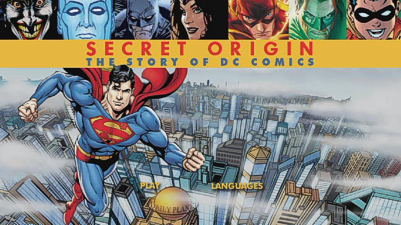
All we get is a basic static menu that replicates the front cover concept, but with a much nicer image of Superman, with the option to play the documentary or select subtitle languages (there isn’t even a Scene Selection, though the disc has chapters encoded randomly at roughly ten minute intervals). What this amounts to is a very “focused” disc that just holds the documentary, giving it a wider use as something that can be included as an extra in other sets, as indeed Secret Origin is on the upcoming Batman Beyond: Complete Series collection, and I wouldn’t be surprised to see it cropping up on other titles too in the future.
Case Study:
Again as basic as they come, Secret Origin doesn’t do the best with what could have been a terrific sleeve illustrated by a noted DC artist of all the primary (and, in the background, not so primary) characters in heroic pose, or maybe a strip panel approach with the established names bursting out from the page? Anything – even a straight line up of notable covers – would have been better than the non-heroic group of images used. Superman, looking striking but rather pensive, naturally takes center stage and most of the real estate, with Watchmen’s Dr Manhattan, Batman, The Flash, Wonder Woman and Green Lantern featured in thumbnails along the top banner.
That’s all repeated on the disc art (which actually works well), while the back of the sleeve does paste in five book covers, but they seem to be fairly random selections and possibly picked more to show the characters’ average styles, with simple explanatory text about the documentary on a plain white background for the remaining two-thirds of the sleeve. While it’s fine to have Secret Origin available as an individual release for those that don’t want to re-purchase the Batman episodes, the lack of too much effort going into the cover art – DC’s 75 years are only mentioned in passing – only again points towards a future as a possible supplemental feature in other titles.
Ink And Paint:
Shot presumably on high-definition video, and without anything else on the disc to compromise the image space, the quality of Secret Origin really is good – with one major caveat. Since it’s basically being a montage of talking heads (not much compression work needed there) and highly graphic images (which are naturally vibrant and easily lose any hint of mosquito noise in their detail), there’s next to no artefacting noticeable and, with the 90 minutes of content making good, though not full, 3.61gb use of the single-layered disc, not much at all to complain about.
Except…for the majority of archive footage and television excerpts, practically all of them not reframed for the 16:9 frame but basically stretched to fit. As an editor myself, the first rule of thumb when dealing with multiple aspect ratios is to fix them to a standard, either by windowboxing 1.33 material or, as is more common in modern documentaries, cropping it by 30% top or bottom to reframe it for current widescreen TV displays.

This is a huge bugbear for me, and I literally rolled my eyes or cringed every time vintage material was used. I don’t remember Americans in the 1930s or the cartoon adaptations of the 60s and 70s featuring short and fat people, but that’s what we see here, and it’s frankly a poor show from editor Yana Gorskaya and director Carter, who should have made sure these fixes were made and carried over into the final mastering of the documentary. As such, it loses vital points from its video score for dropping the ball so spectacularly over such a fundamentally basic issue that one doesn’t expect to see in an obviously well-funded product.
Scratch Tracks:
Bringing some life to the otherwise dialogue heavy soundtrack, which is essentially all Reynolds’ voiceover and the participants’ interviews, is a synthesized score by Shaun Drew, which runs the gamut between dark and deadly Batman-esque strings to high-flying heroic brass, basically sounding like a very good episode of Smallville. At times, I did wish the never-ending music would do its own super-vanishing trick, often when stories become more interesting, but ultimately I’d much rather the documentary to feature this music than not, since it has its moments and particularly helps define some characters who were never depicted on the screen. So to have a little music for them as their images zip by does help to make some of the comics more powerful, and it’s been placed low enough in the mix not to frustrate too often. Films and television clips look and sound appropriate to their vintages, though as always when John Williams’ Superman March inevitably storms in for a couple of minutes, I wouldn’t have minded hearing the whole thing in full! Subtitles for English, French, Japanese, Portuguese and Spanish are included.
Final Cut:
One just can’t help but wonder if Secret Origin was a bonus feature that grew to super-heroic proportions and resulted in the documentary being made available individually in order to recoup some costs. It comes to disc without any major DC-related titles coming to home video or theaters, other than being included as the extra it often feels like in the Batman Beyond set. If celebrating the imprint’s 75 year anniversary is the aim, then it does so adequately, without any truly revealing insights, but hard-core collectors might do better to seek out any of the numerous publications also honouring that milestone.
The Green Lantern-Ryan Reynolds connection suggests something more along the lines of the Kevin (Lex Luthor) Spacey-narrated Story Of Superman from a few years back, but Secret Origin: The History Of DC Comics stands much more on its own two feet than that, which further suggests we might see it emerge again on upcoming releases, perhaps in HD with the eventual Blu-ray of the Green Lantern feature film. As such, $25 is overpricing this individual release by at least $10, making it more of a rental for those curious.
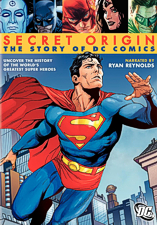 | ||
 |








